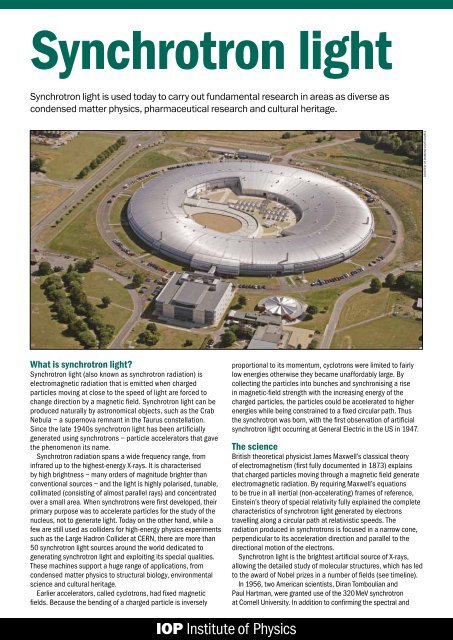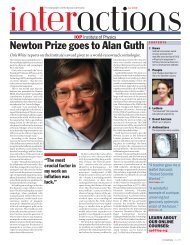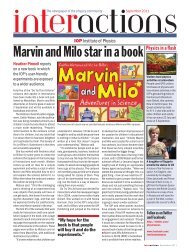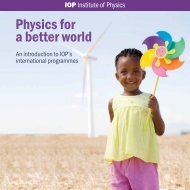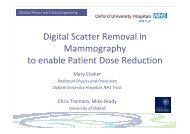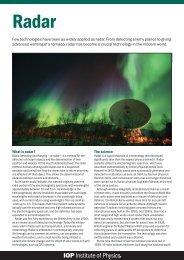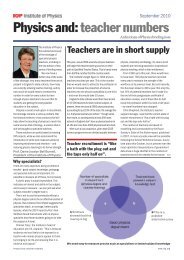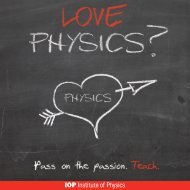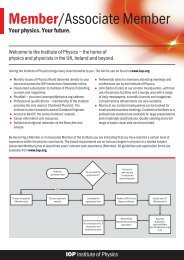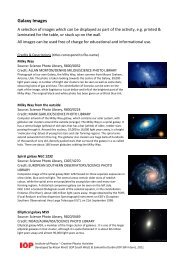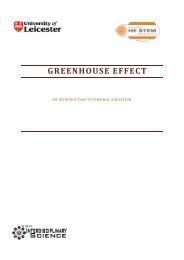Synchrotron light - Institute of Physics
Synchrotron light - Institute of Physics
Synchrotron light - Institute of Physics
You also want an ePaper? Increase the reach of your titles
YUMPU automatically turns print PDFs into web optimized ePapers that Google loves.
<strong>Synchrotron</strong> <strong>light</strong><br />
<strong>Synchrotron</strong> <strong>light</strong> is used today to carry out fundamental research in areas as diverse as<br />
condensed matter physics, pharmaceutical research and cultural heritage.<br />
What is synchrotron <strong>light</strong>?<br />
<strong>Synchrotron</strong> <strong>light</strong> (also known as synchrotron radiation) is<br />
electromagnetic radiation that is emitted when charged<br />
particles moving at close to the speed <strong>of</strong> <strong>light</strong> are forced to<br />
change direction by a magnetic field. <strong>Synchrotron</strong> <strong>light</strong> can be<br />
produced naturally by astronomical objects, such as the Crab<br />
Nebula – a supernova remnant in the Taurus constellation.<br />
Since the late 1940s synchrotron <strong>light</strong> has been artificially<br />
generated using synchrotrons – particle accelerators that gave<br />
the phenomenon its name.<br />
<strong>Synchrotron</strong> radiation spans a wide frequency range, from<br />
infrared up to the highest-energy X-rays. It is characterised<br />
by high brightness – many orders <strong>of</strong> magnitude brighter than<br />
conventional sources – and the <strong>light</strong> is highly polarised, tunable,<br />
collimated (consisting <strong>of</strong> almost parallel rays) and concentrated<br />
over a small area. When synchrotrons were first developed, their<br />
primary purpose was to accelerate particles for the study <strong>of</strong> the<br />
nucleus, not to generate <strong>light</strong>. Today on the other hand, while a<br />
few are still used as colliders for high-energy physics experiments<br />
such as the Large Hadron Collider at CERN, there are more than<br />
50 synchrotron <strong>light</strong> sources around the world dedicated to<br />
generating synchrotron <strong>light</strong> and exploiting its special qualities.<br />
These machines support a huge range <strong>of</strong> applications, from<br />
condensed matter physics to structural biology, environmental<br />
science and cultural heritage.<br />
Earlier accelerators, called cyclotrons, had fixed magnetic<br />
fields. Because the bending <strong>of</strong> a charged particle is inversely<br />
proportional to its momentum, cyclotrons were limited to fairly<br />
low energies otherwise they became unaffordably large. By<br />
collecting the particles into bunches and synchronising a rise<br />
in magnetic-field strength with the increasing energy <strong>of</strong> the<br />
charged particles, the particles could be accelerated to higher<br />
energies while being constrained to a fixed circular path. Thus<br />
the synchrotron was born, with the first observation <strong>of</strong> artificial<br />
synchrotron <strong>light</strong> occurring at General Electric in the US in 1947.<br />
The science<br />
British theoretical physicist James Maxwell’s classical theory<br />
<strong>of</strong> electromagnetism (first fully documented in 1873) explains<br />
that charged particles moving through a magnetic field generate<br />
electromagnetic radiation. By requiring Maxwell’s equations<br />
to be true in all inertial (non-accelerating) frames <strong>of</strong> reference,<br />
Einstein’s theory <strong>of</strong> special relativity fully explained the complete<br />
characteristics <strong>of</strong> synchrotron <strong>light</strong> generated by electrons<br />
travelling along a circular path at relativistic speeds. The<br />
radiation produced in synchrotrons is focused in a narrow cone,<br />
perpendicular to its acceleration direction and parallel to the<br />
directional motion <strong>of</strong> the electrons.<br />
<strong>Synchrotron</strong> <strong>light</strong> is the brightest artificial source <strong>of</strong> X-rays,<br />
allowing the detailed study <strong>of</strong> molecular structures, which has led<br />
to the award <strong>of</strong> Nobel prizes in a number <strong>of</strong> fields (see timeline).<br />
In 1956, two American scientists, Diran Tomboulian and<br />
Paul Hartman, were granted use <strong>of</strong> the 320 MeV synchrotron<br />
at Cornell University. In addition to confirming the spectral and<br />
CoURTESy <strong>of</strong> DIAMoND LIGHT SoURCE
angular distribution <strong>of</strong> synchrotron <strong>light</strong>, they carried out the<br />
first X-ray spectroscopy study using synchrotron <strong>light</strong>. five years<br />
later, the National Bureau <strong>of</strong> Standards in the US modified its<br />
180 MeV machine to allow synchrotron <strong>light</strong> to be harvested<br />
for experiments. These became known as the first-generation<br />
synchrotrons – machines built for smashing nuclei apart using<br />
electrons, which were later used for synchrotron-<strong>light</strong> experiments.<br />
over the coming decades, as demand grew for the use <strong>of</strong> firstgeneration<br />
synchrotron machines, pioneering advances led to a<br />
number <strong>of</strong> developments, such as the storage ring, which allowed<br />
particles to circulate for long periods <strong>of</strong> time providing more<br />
stable beam conditions, benefiting both particle physicists and<br />
synchrotron users. one <strong>of</strong> the most significant developments took<br />
place in the late 1970s when plans were approved to build the<br />
world’s first dedicated synchrotron <strong>light</strong> source producing X-rays<br />
(<strong>Synchrotron</strong> Radiation Source – SRS) at Daresbury in the UK,<br />
which started user experiments in 1981. The US, Japan and others<br />
also built second-generation machines, while other first-generation<br />
machines received upgrades to allow for more experiments.<br />
for scientists carrying out spectroscopy experiments, the<br />
brightness <strong>of</strong> the beam reaching the sample determined the<br />
resolving power <strong>of</strong> the results. for crystallographers, especially<br />
those looking at small crystals with large unit cells, high<br />
brightness was important to resolve closely spaced diffraction<br />
spots. As second-generation machines were optimised to<br />
produce brighter beams, a fundamental limit was approaching.<br />
To meet the increasing demands <strong>of</strong> a growing synchrotron user<br />
community, a new approach was required: insertion devices.<br />
Insertion devices are arrays <strong>of</strong> magnets placed into the straight<br />
sections <strong>of</strong> the storage ring, which could be retro-fitted to<br />
second-generation machines and were quickly incorporated into<br />
existing synchrotrons. Insertion devices help to create a beam<br />
that is very bright and with intensity peaks with a wavelength<br />
that can be varied by adjusting the field strength (<strong>of</strong>ten the gap<br />
between two magnet arrays).<br />
The increased brightness made data collection faster,<br />
and tunable wavelengths benefited crystallographers and<br />
spectroscopists alike. By the early 1990s machines were being<br />
designed with insertion devices in place from the start, and the<br />
first such third-generation source, the European <strong>Synchrotron</strong><br />
Radiation facility (ESRf) in Grenoble, france, started operating in<br />
1994. There are now more than 50 dedicated <strong>light</strong> sources in the<br />
world, combining both second- and third-generation machines,<br />
which cover a wide spectral range from infrared to hard X-rays.<br />
The experimental configurations <strong>of</strong> different synchrotron<br />
facilities are quite similar. The storage rings where the <strong>light</strong> is<br />
<strong>Synchrotron</strong> <strong>light</strong><br />
CoURTESy <strong>of</strong> RICK LEWIS AND JoN MARLES-WRIGHT, NEWCASTLE UNIVERSITy<br />
generated have many ports, which each open onto a beamline,<br />
where scientists set up their experiments and collect data. The<br />
beamlines, however, can vary a lot in the details depending on<br />
the experimental methods they are used for. The Diamond Light<br />
Source in oxfordshire became Britain’s newest synchrotron<br />
<strong>light</strong> facility in 2007 and in August 2008 it was Britain’s only<br />
synchrotron source following the closure <strong>of</strong> the SRS. It represents<br />
the largest single UK science investment for 40 years and will<br />
have the capacity to host 40 beamlines. The Diamond Light<br />
Source supports a huge range <strong>of</strong> scientific disciplines, including<br />
condensed matter physics, chemistry, nanophysics, structural<br />
biology, engineering, environmental science and cultural heritage.<br />
Applications<br />
●●Life science<br />
Pharmaceutical companies and medical researchers are making<br />
increasing use <strong>of</strong> macromolecular crystallography. Improvements<br />
in the speed <strong>of</strong> data collection and solving structures mean<br />
that it is now possible to obtain structural information on a<br />
timescale that allows chemists and structural biologists to work<br />
together in the development <strong>of</strong> promising compounds into drug<br />
candidates. Both the anti-flu drug Tamiflu and Herceptin – used<br />
to treat advanced breast cancer – benefited from synchrotron<br />
experiments. Using synchrotron <strong>light</strong> in the infrared range,<br />
pioneering research is underway into developing new cancer<br />
therapies that can be tailored to the individual patient. In 2009,<br />
the Medical Research Council used the Diamond Light Source to<br />
compare the structure <strong>of</strong> hemagglutinin from the flu-virus strain<br />
that caused the 1957 “Asian” pandemic with the 1918 and 1968<br />
outbreaks, to discover why some avian flu viruses are more able<br />
than others to jump the species gap.<br />
●●Engineering <strong>Synchrotron</strong> X-ray beams allow detailed analysis and modelling<br />
<strong>of</strong> strain, cracks and corrosion as well as in situ study <strong>of</strong><br />
materials during production processing. This research is vital to<br />
the development <strong>of</strong> high-performance materials and their use in<br />
innovative products and structures. The Diamond Light Source<br />
has been used to study the processes behind pitting corrosion,<br />
which attacks the so-called corrosion-resistant metals used in<br />
containers for nuclear waste, and to understand how applied<br />
stresses can cause cracks to propagate through materials.<br />
●●Environmental science<br />
<strong>Synchrotron</strong>-based techniques have made a major impact<br />
CoURTESy <strong>of</strong> DIAMoND LIGHT SoURCE
Timeline<br />
1873 James Clerk Maxwell publishes his theory <strong>of</strong> electromagnetism.<br />
1895 Wilhelm Röntgen discovers X-rays, for which he wins the inaugural Nobel Prize in <strong>Physics</strong> in 1901.<br />
1897 Sir Joseph Larmor shows mathematically that radiation is emitted by accelerated charged particles.<br />
1898 Alfred-Marie Liénard realises particles moving in a circle will produce this radiation as a result <strong>of</strong> centripetal acceleration.<br />
years later, this work was built on by George Adolphus Schott, the British mathematician, who published his classical work<br />
on electromagnetic radiation.<br />
1912 Max von Laue obtains the first X-ray diffraction pattern <strong>of</strong> a crystal.<br />
1914 Sir William Henry Bragg and William Lawrence Bragg in London and Manchester, respectively, extend the use <strong>of</strong> X-ray<br />
diffraction as a technique for determining crystal structure, for which they shared a Nobel Prize in <strong>Physics</strong> in 1915.<br />
1946 first synchrotron operates in Woolwich, UK.<br />
1947 first observation <strong>of</strong> synchrotron <strong>light</strong>.<br />
1949 American physicist Julian Schwinger documents the full theory <strong>of</strong> a relativistic electron on a circular path producing radiation.<br />
1953 Structure <strong>of</strong> DNA solved using X-rays.<br />
1956 first experiments using synchrotron <strong>light</strong> take place at Cornell, US.<br />
1959 Max Perutz at the Cavendish Laboratory in Cambridge uses X-ray crystallography to determine the structure <strong>of</strong> haemoglobin,<br />
for which he wins the Nobel Prize in Chemistry in 1962.<br />
1964 The DESy synchrotron in Germany begins operation for both high-energy physics and synchrotron-<strong>light</strong> experiments.<br />
1966 first experiments in the UK at Glasgow synchrotron.<br />
1977 first demonstration <strong>of</strong> free-electron-laser (fEL) principle at Stanford, US.<br />
1981 The <strong>Synchrotron</strong> Radiation Source (SRS) starts operating in Daresbury, UK. It is the first dedicated X-ray producing<br />
synchrotron source.<br />
1994 The first third-generation synchrotron source, the ESRf in Grenoble, france, goes into operation.<br />
1997 Sir John Walker wins the Nobel Prize in Chemistry for his work on the structure <strong>of</strong> Bovine f1 ATP synthase, based on<br />
research using the SRS.<br />
2000 The SASE principle for an fEL is successfully demonstrated at DESy.<br />
2005 fLASH, the first fEL in the s<strong>of</strong>t X-ray range, goes into operation at DESy.<br />
2007 The Diamond Light Source starts operation as a next-generation user facility in the UK.<br />
2008 The SRS closes after 28 years <strong>of</strong> operation and 2 million hours <strong>of</strong> user beamtime. The Diamond Light Source takes over as<br />
the UK national facility.<br />
2009 The Linac Coherent Light Source, the first hard X-ray XfEL, goes into operation in the US. Venkatraman Ramakrishnan,<br />
Thomas A Steitz and Ada E yonath are awarded the Nobel Prize in Chemistry for revealing the structure <strong>of</strong> the ribosome,<br />
for which they used synchrotron <strong>light</strong>.<br />
in the field <strong>of</strong> environmental science in the last 10 years.<br />
High brightness allows high-resolution study <strong>of</strong> ultra-dilute<br />
substances, the identification <strong>of</strong> species and the ability to track<br />
pollutants as they move through the environment. <strong>Synchrotron</strong>s<br />
have been used to develop more efficient techniques for<br />
hydrogen storage and to study the way in which depleted<br />
uranium disperses into the local environment. Tiny heavy-metal<br />
samples excreted from earthworms have been compared with<br />
contaminated soil samples, revealing how earthworms survive<br />
in these environments and introducing the idea that earthworms<br />
could help to decontaminate land.<br />
●●<strong>Physics</strong> and materials science<br />
Determining the properties and morphology <strong>of</strong> buried layers<br />
and interfaces is an important area in solid-state science with<br />
synchrotrons being the meeting ground <strong>of</strong> state-<strong>of</strong>-the-art theory<br />
and high-precision experimental results. Many <strong>of</strong> the technological<br />
“<strong>Synchrotron</strong> <strong>light</strong> is the<br />
brightest artificial source<br />
<strong>of</strong> X-rays.”<br />
products <strong>of</strong> materials science are based on thin-film devices,<br />
which consist <strong>of</strong> a series <strong>of</strong> such layers. Structural studies <strong>of</strong><br />
in situ processing <strong>of</strong> semiconducting polymer films are also<br />
likely to be an important area <strong>of</strong> growth in the coming decade.<br />
Diffraction <strong>of</strong> high-intensity X-ray beams is an ideal technique to<br />
study spin, charge and orbital ordering in single-crystal samples<br />
to understand high-temperature superconductivity. The SRS was<br />
used to help study giant magneto-resistance (GMR), which is now<br />
used in billions <strong>of</strong> electronic devices worldwide.<br />
<strong>Synchrotron</strong> <strong>light</strong>
●●Cultural heritage<br />
Cultural heritage is a rapidly expanding area <strong>of</strong> research using<br />
synchrotrons. Scientists are using non-destructive synchrotron<br />
techniques to find answers to big questions in palaeontology,<br />
archaeology, art history and forensics. Scientists in the UK<br />
have used the SRS and the Diamond Light Source to study<br />
samples from the Tudor warship the Mary Rose to enhance their<br />
conservation techniques, and the ESRf has been used to study<br />
insects more than 100 million years old, preserved in amber.<br />
Impacts<br />
Seven Nobel Prizes in <strong>Physics</strong> have been awarded for X-ray related<br />
work. for example, British physicists Sir William Henry Bragg and<br />
William Lawrence Bragg shared the 1915 prize for using X-ray<br />
diffraction as a technique to determine crystal structure.<br />
<strong>Synchrotron</strong> facilities have had a positive and significant<br />
impact on many areas. In technology, research into GMR is<br />
now benefiting data storage in billions <strong>of</strong> electronic devices like<br />
iPods – a market generating £1 bn per quarter. At the time the<br />
SRS closed in 2008, 11 <strong>of</strong> the top 25 companies in the UK R&D<br />
Scoreboard had used the facility.<br />
Sir John Walker was awarded the Nobel Prize in Chemistry in<br />
1997 for his work on the structure <strong>of</strong> Bovine f1 ATP Synthase<br />
– the first synchrotron-based Nobel prize. In 2006, the Nobel<br />
Prize in Chemistry was awarded to Pr<strong>of</strong>. Roger Kornberg for his<br />
synchrotron-based research into how genes copy themselves,<br />
a process involved in many human diseases and stem-cell<br />
treatment. The structure <strong>of</strong> the foot-and-mouth-disease virus<br />
was determined first at the SRS, leading to potential new<br />
vaccines that could save the UK £80 m if another outbreak were<br />
to occur. <strong>Synchrotron</strong> <strong>light</strong> is considered essential in modern<br />
pharmaceutical research, illustrated by the 14% investment in<br />
the Diamond Light Source by the Wellcome Trust, the UK’s largest<br />
non-governmental funding body for biomedical research.<br />
Throughout the lifetime <strong>of</strong> synchrotron facilities, 300 local<br />
businesses benefited from the SRS, with £300 m being awarded<br />
in contracts – the financial impact on the local economy<br />
throughout its lifetime is estimated to be almost £1 bn. Similarly,<br />
more than 1000 companies have benefited from construction or<br />
technology contracts for the Diamond Light Source and a quarter<br />
<strong>of</strong> the science carried out at the ESRf links directly to industry.<br />
Key facts and figures<br />
●●There are around 50 synchrotron <strong>light</strong> sources around the world.<br />
●●<strong>Synchrotron</strong>s are used by industry, with 11 <strong>of</strong> the companies in<br />
the UK Top 25 R&D Scoreboard 2008 having used the SRS.<br />
●●Pharmaceutical companies use synchrotrons as part <strong>of</strong> the<br />
drug-development process, creating new products that have the<br />
potential to save the UK economy huge sums <strong>of</strong> money.<br />
●●19 Nobel prizes have been awarded for research involving<br />
X-rays; nine in chemistry (<strong>of</strong> which four used synchrotron X-rays),<br />
seven in physics and three in medicine.<br />
●●<strong>Synchrotron</strong> sources boost local economies through local<br />
construction and maintenance contracts worth hundreds <strong>of</strong><br />
millions <strong>of</strong> pounds.<br />
Useful links<br />
●●www.<strong>light</strong>sources.org/ ●●www.diamond.ac.uk/Home/About/<strong>Synchrotron</strong>s.html ●●http://xdb.lbl.gov/Section2/Sec_2-2.html ●●www.esrf.eu/files/Brochures/LeadingScienceforEurope.pdf ●●http://en.wikipedia.org/wiki/<strong>Synchrotron</strong>_<strong>light</strong> Future developments<br />
The demand for synchrotron <strong>light</strong> has meant that third-generation<br />
machines are being built around the world, and existing machines<br />
continue to be developed to provide brighter X-rays, increased<br />
user hours and more flexible experimental stations. The modular<br />
nature <strong>of</strong> modern synchrotrons means that new technologies can<br />
be incorporated into existing machines as they arrive. By using<br />
powerful linear accelerator technology, fourth-generation sources<br />
– known as free-electron lasers (fELs) – can generate shorter,<br />
femtosecond pulses but with the same intensity in each peak as<br />
synchrotron sources emit in one second, producing X-rays that are<br />
millions <strong>of</strong> times brighter in each pulse than the most powerful<br />
synchrotrons. fELs won’t replace third-generation machines, but<br />
will provide facilities that enable studies at higher peak brightness.<br />
●●Thanks go to Gerhard Materlik and Sara fletcher, the Diamond<br />
Light Source; Claire Dougan, STfC; and Emma Woodfield for<br />
their help with this case study.<br />
●●for further information about this case study, contact Tajinder<br />
Panesor (e-mail tajinder.panesor@iop.org).<br />
The <strong>Institute</strong> <strong>of</strong> <strong>Physics</strong><br />
76 Portland Place, London W1B 1NT<br />
Tel +44 (0)20 7470 4800<br />
fax +44 (0)20 7470 4848<br />
E-mail physics@iop.org<br />
www.iop.org<br />
The <strong>Institute</strong> <strong>of</strong> <strong>Physics</strong> is a scientific charity devoted to increasing<br />
the practice, understanding and application <strong>of</strong> physics. It has a<br />
worldwide membership <strong>of</strong> around 40 000 and is a leading<br />
communicator <strong>of</strong> physics-related science to all audiences, from<br />
specialists through to government and the general public. Its<br />
publishing company, IoP Publishing, is a world leader in scientific<br />
publishing and the electronic dissemination <strong>of</strong> physics.<br />
<strong>Synchrotron</strong> <strong>light</strong> © <strong>Institute</strong> <strong>of</strong> <strong>Physics</strong> 2010


